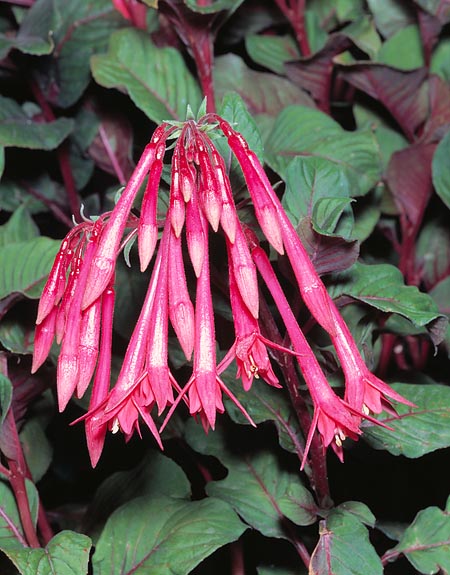Family : Onagraceae

Text © Pietro Puccio

English translation by Mario Beltramini

Fuchsia corymbiflora is easy to till but fears the cold © Giuseppe Mazza
The genus is honoured to the German physician and botanist Leonhart Fuchs (1501-1566); the name of the species is the combination of the Latin terms “corymbus” = corymb, cluster and “flora”, from “flos, -oris” = flower, with obvious reference.
Common names: cluster-flowered fuchsia (English); brinco de princesa (Portuguese).
The Fuchsia corymbiflora Ruiz & Pav. (1802) is a deciduous shrub, tall up to about 4 m, with erect or drooping stems; the juvenile branches are red or purple red.
The leaves, on a 0,5-2 cm long petiole, are opposite, at times in verticils (that is, inserted in the same node) of three, oblong-lanceolate, slightly velvety, 6-15 cm long and 3-6 cm broad, of intense green colour on the upper page, paler below, slightly toothed margin and pointed apex.
Terminal inflorescences in drooping or arcuate corymbs with 2-8 cm long rachis (axis of the inflorescence); the single flowers have 0,5-1,5 cm long, lanceolate bracts, pink to bright red funnel-shaped calyx, thin at the base, 4-7 cm long and broad at the apex about 0,6 cm, 4 oblong-lanceolate sepals, about 1,5 cm long and 0,5 cm broad and oblong petals, darker than the sepals, about 1,5 cm long and 0,5 cm broad.
The fruits are subglobose, about 1 cm long, red, berries, containing several seeds, about 2 mm long.
It reproduces by seed, which must be fresh as it has a short lasting germinating time, placed superficially in sandy soil, rich of organic substance and kept constantly humid at the temperature of 20-22 °C; the germination takes place in 1-2 months, or by cutting, in summer and by division of root suckers.
Much ornamental species and easy to cultivate, it prefers slightly shaded positions and soils preferably acidic or neutral, sandy and rich of organic substance, kept humid. It is suitable for humid subtropical climates and, marginally, warm temperate ones, temperatures just below the 0 °C destroy the aerial part, but the plant vegetates again from the base in spring, especially if well mulched.
Where the climate doesn’t allow the permanent cultivation in open air, it can be cultivated in pot but must be sheltered in winter in a luminous location, away from heat sources which may dry up the air too much.
Synonyms: Fuchsia corymbosa Pritz. (1886); Fuchsia velutina I.M.Johnst. (1925); Fuchsia munzii J.F.Macbr. (1941).
→ To appreciate the biodiversity within ONAGRACEAE family please click here.
